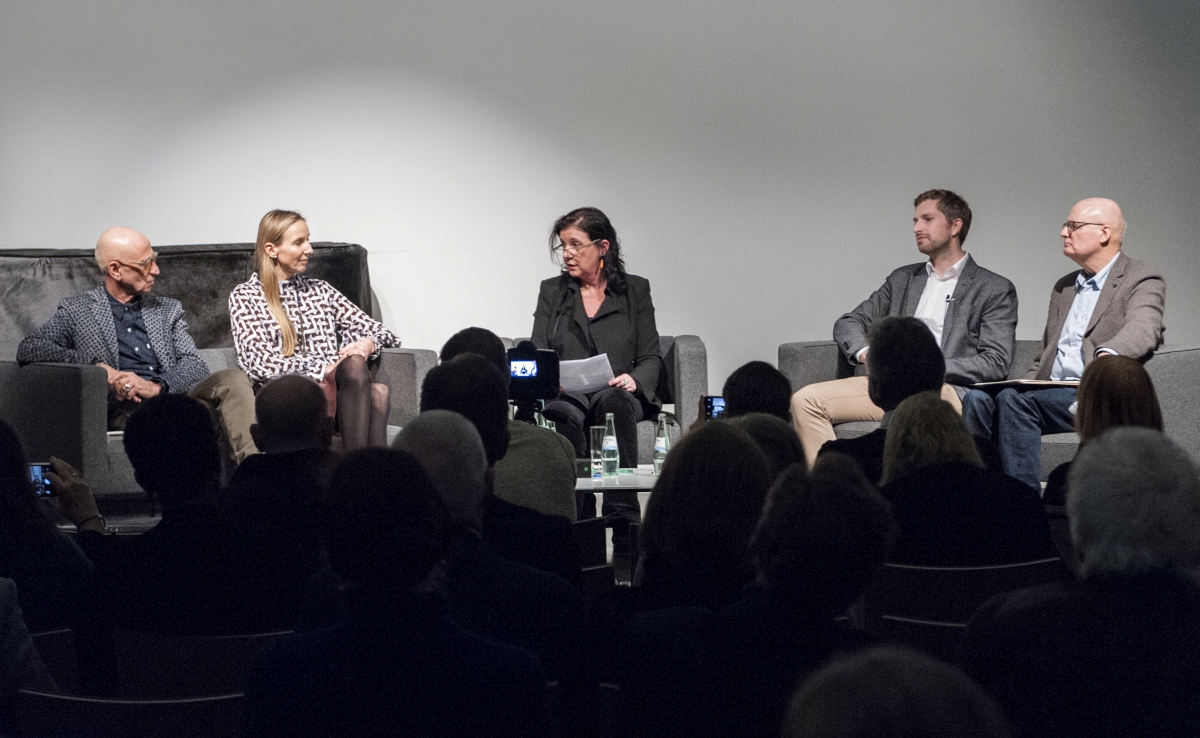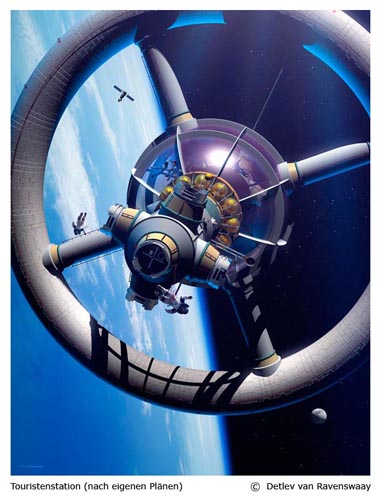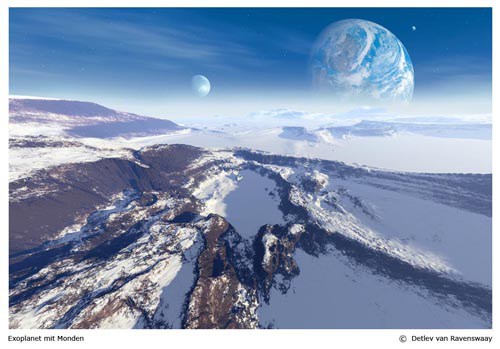Text: Peter Tepe | Section: On ‚Art and Science‘
Abstract: Can art inspire science? Peter Tepe argues it can, and gives examples of just such an influence. In doing so, he discovers that he is dealing with constellations in which certain forms of art have an impact on certain forms of science. Space Art, for example, often encourages the motivation of astronauts, as well as space-researchers and -engineers.
Translator’s note
In English, the term ‘science’ usually refers to the natural sciences. In this article, however, it is used as a direct translation of the German term ‘Wissenschaft’ which encompasses not only the natural sciences, but also the social sciences and humanities. The same goes for the German term ‘Wissenschaftler’ which encompasses not only natural scientists, but also academics and researchers. Therefore, academic disciplines such as Kunstwissenschaften (rendered in this article as „the study of art“) and Rechtswissenschaften (rendered as „legal studies“) are also referred to as ‘sciences’ for the purpose of this article.
Background
The exhibition ART INSPIRATION SCIENCE [KUNST INSPIRATION WISSENSCHAFT] opened on 19.10.2018. The title is a condensed version of Thomas Schönauer’s initial proposal Science inspires Art — Art inspires Science. In the panel discussion accompanying the exhibition (29.11.2018) we only briefly touched upon the topic “Science inspires Art” as it is undisputed that many artists rely upon various scientific theories/methods/results in their artistic practice. BioArt, to name one representative example, is a widespread form of science-related art.
We focused more on the topic of “Art inspires Science” due to the ambiguity surrounding it; perhaps the question of whether this relationship even exists already divides opinion. If it is claimed that such a relationship does exist, detailed examples of how science is inspired by art should be given based on one’s own field of experience. The aim of the panel discussion was to collect ideas and discuss them freely in order to arrive at initial results that inspire further reflection. In this w/k article I elaborate on my preparations for this discussion.
Before we begin, a note on the word “inspiration”. The question “Can art inspire science (and if yes, how so)?” was interpreted in the panel discussion — and is interpreted in my article — in general terms. It is similar to the questions “Can art influence science?” and “Can art have an impact on science?”. Clarifications of the terminology should be considered where necessary and they are fundamentally useful.
Changing the central question
If we answer the question “Can art inspire/influence science? Can it have an impact on it?” with “yes” we are left with statements that in some way define the impact of the arts in general on the sciences in general. So far, however, I have only come across constellations in which certain forms of art have an impact on certain forms of science. Having said that, I do not reject the idea that the arts in general could have an overall influence on the sciences in general. I therefore suggest we do not start with the broader question “Can the arts in general inspire/influence the sciences in general?”, but rather with the more specific question “Can certain forms of art inspire/influence certain forms of science?”. If there are viable answers to this question, only then can we return to the broader question and consider whether the arts in general have an influence on the sciences in general that goes beyond the limited and specific influences. I think it is not useful to start with the broader question as this will lead us to a dead end.
I therefore narrow the question down to specifically address the inspiration/influence that certain forms of art have on certain forms of science. Based on the current state of my investigations so far, which is subject to change through convincing examples and valid arguments, I distinguish between five types.
New developments in the arts influence the study of art [Kunstwissenschaften]
Type 1. First, I examine the study of art in a broader sense. It includes the study of: literature, theatre, music, visual arts and film. New developments in an art form, for example current trends in literature, sooner or later lead academics in the corresponding discipline (in this case literary scholars) to study them more closely in various ways. This type of “Art inspires Science” does not require further discussion; it is indisputable.
With regard to the central question, the point here is that new developments in literature influence and have an impact on literary studies, as well as some other disciplines that also deal with current art trends, such as history. The point is not that the arts in general influence the sciences in general.
New developments in the arts influence legal studies [Rechtswissenschaften]
Type 2. In the second step — inspired by Peter Lynen from the NRW Academy of Sciences, Humanities and the Arts — I focus on law and legal studies, as here there is a similar kind of connection: new developments in an art form sometimes lead to legal problems which sooner or later also concern legal scholars. In this context, artists can stimulate the law. Think of copyright on art products in digital media, for example. This type of “Art inspires Science” does not require further discussion either; it is indisputable. Likewise, this field is not about the arts in general influencing the sciences in general.
In the following reflections I exclude types 1 and 2 and ask whether certain forms of art can have an impact on sciences such as maths, physics, chemistry, biology, psychology, the social sciences, economics or philosophy. I consider this the main issue regarding the topic “Art inspires Science”. There are at least three forms of such a specific impact/influence/inspiration.
Works of a certain art form can motivate scientists
Type 3. I draw on an example given by the Space-Artist Detlev van Ravenswaay in a w/k artist interview. Space Art or Astronomical Art orients itself on research in astronomy and physics, as well as on the current state of development of space technology. The Space Artists strive to keep up-to-date with scientific and technical knowledge in their artistic works, whilst following a realistic art programme.
In van Ravenswaay’s experience, Space Art has, in many cases, encouraged the motivation of astronauts, space-researchers and -engineers. This is because if a certain type of art (here: Space Art) excites scientists, engineers, etc., who deal with the same phenomena, then this enthusiasm can have a positive effect on the motivation of these scientists, engineers, etc. A painting of a yet non-existent, but planned space station, for example, can encourage these people to pursue their ambitious goals. To summarise: a certain form of art can motivate certain scientists (as well as the engineers, etc. working in collaboration with them).
The existence of types 1 and 2 are undisputed; there is nothing surprising about them. Type 3, however, is a little more unexpected. This form of “Art inspires Science” is different from types 1 and 2.
To elaborate on the theoretical explanations of type 3: if an artist and a scientist are dealing with the same topics, and if their basic assumptions, values and goals are in affinity, then the admiration for an artwork stemming from this context can validate, as well as release additional energies for the scientist’s direction of research. Art of a certain kind can thus support and reinforce a certain scientific commitment — it can boost the motivation of like-minded scientists.
Type 3, too, is not about art in general influencing science in general (in this respect, it is consistent with types 1 and 2). This is also supported by the fact that many scientists have little or nothing to do with Space Art – it does not appeal to them. I attribute this indifference towards Space Art, which can go as far as rejection, mainly to the fact that the basic assumptions, values and goals of these scientists are not in affinity with those of the Space Artists; their belief systems do not, in their core aspects, coincide.
Works of a certain art form can act as a source of ideas
Type 4. Imagine the following situation: in one science/technology group, the aim is to build novel aircrafts. Upon reading a science fiction novel, one member of this group encounters a crazy aircraft. As a result, their thinking (and thus the thinking of the whole group) can take a new direction; they now attempt to actually manufacture the aircraft — or at least a similar one.
In more general terms, if artists and scientists deal with the same topics, and if their motivations largely coincide, then an idea articulated in an artwork can inspire scientists to seize this idea and to use scientific means to put it into practice. Specifically, art of a certain kind can act as a source of ideas — especially for practical projects — for like-minded scientists. This will mainly be the case for artists who deal with future development possibilities and envision potential scenarios (science fiction authors are just one example). Visionary art can have an inspiring, stimulating effect on certain areas of science/technology.
Type 4 also comes in another variation. I come back to an example given by van Ravenswaay:
“Around 20 years ago, the astronomer Michael Major discovered the first exoplanet, which orbits another star in our galaxy. Decades earlier, however, astronomical artists already painted scenes of such planetary systems. These paintings also revealed exoplanets passing in front of the ‘stellar pane’. Certain works of astronomical art could thus inspire space researchers to develop theories about exoplanets.”
If these statements stand up to scrutiny, then a second variant of type 4 exists. Certain scientists then ask themselves: “Does what is represented in Space Art actually exist?” Certain works of Space Art thus incite these scientists to prove by specific scientific means that exoplanets do exist.
In summary, art of a certain kind can inspire new ideas for science of a certain kind, which are then pursued by scientific (and, of course, technical) means. There are two variations:
Type 4a. A certain form of art (e.g. a science fiction novel) gives scientists new ideas for products (e.g. for a new aircraft)
Type 4b. A certain form of art (e.g. a Space Art graphic showing an exoplanet) gives scientists the new idea that something like this could actually exist, motivating these scientists to try to prove its existence by scientific means.
Type 4 does not indicate that art in general influences science in general either.
Works of a certain art form can help finance scientific research projects
Type 5. If we interpret “Art inspires Science” to mean “art has an impact on science”, then we must consider another constellation. A certain form of art can support certain scientists in financing scientific research projects — I am thinking in particular about large-scale science and technology projects. Such major projects, for example in space travel, are extremely expensive; realising them would require raising a lot of money. Artists who show support for such projects (painters, photographers, filmmakers, etc.) can help raise the money needed for the major project in question through their works. However, unlike types 3 and 4, this is about potential donors (rather than scientists) being inspired by a certain form of art.
There may well be other specific forms of “Art inspires Science”; I will continue to add any relevant suggestions to the theoretical concept. Whilst types 1 and 2 are indisputable, types 3, 4 and 5 point to constellations that do not, or only marginally, exist in the public consciousness: art as a motivator, art as a source of ideas — for new products on the one hand, for scientific engagement with existential assumptions on the other — and art as a supporter in finding sponsors for larger projects.
Can artworks influence the development of highly complex scientific theories?
In principle, it is easy to understand that works of Space Art showing exoplanets can prompt physicists, astronomers and other scientists to think about whether exoplanets actually exist. This question of existence is then addressed within the theoretical framework established in these disciplines. But can artworks also influence the development/advancement of such theories?
Let us imagine for a moment an artist whose work is oriented towards certain forms of modern physics and has also acquired some specialist knowledge through reading and personal contacts. It is very unlikely that such an artist can directly contribute to the development of highly complex theories in physics (as well as their critical evaluation) through their works. Anyone who assumes such a ‘strong’ form of inspiration has the argumentative duty to provide examples proving their theory. At the current level of knowledge I primarily reckon with inspirations/influences/impacts that lie below the construction of highly complex theories — art as a motivator, as well as art as a source of ideas (described above). Both inspirations take place within the framework of certain extremely general theories (e.g. of physics) that are widely accepted among experts.
The reception of art can contribute to the development of a new theory
Finally, I come to the question “How did a scientist come up with the main ideas for their new theory?”. A variety of factors can positively influence the generation of ideas. In some cases, the reception of an art phenomenon can certainly contribute to the development of a new theory. This does not mean that the respective artwork has already laid out the theory in question, but rather that we must consider a process of the following kind: after years of work, a new theory has begun to crystallise, but some elements have not yet been successfully integrated. The encounter with a certain artwork that has the relevant qualities can bring about the sparking idea that enables these final steps. “Art inspires Science” applies to precisely this context.
It would be great if a discussion about “Art inspires Science” could take place in w/k, to possibly further develop the ideas presented here. I would like to thank the editors Till Bödeker, Irene Daum, Peter Lynen and Markus Schrenk for sharing their ideas with me on this topic in preparation of the panel discussion.
Picture above the text: Panel discussion with Thomas Schönauer (2018). Photo: Karsten Enderlein.
How to cite this article
Peter Tepe (2020): On: Art Inspires Science. w/k–Between Science & Art Journal. https://doi.org/10.55597/e6560




Be First to Comment